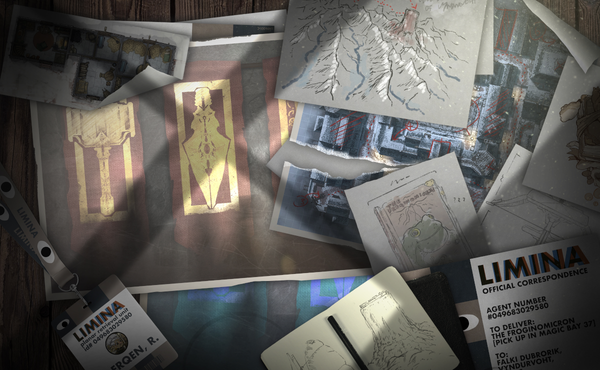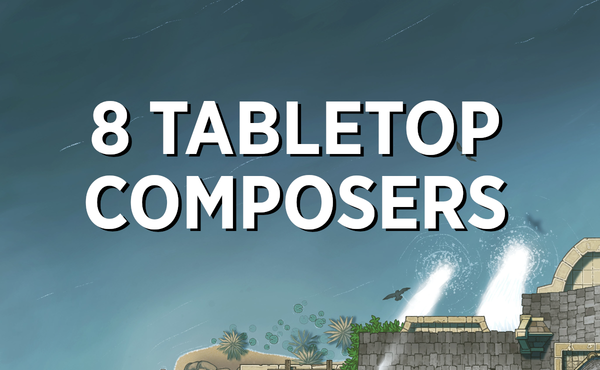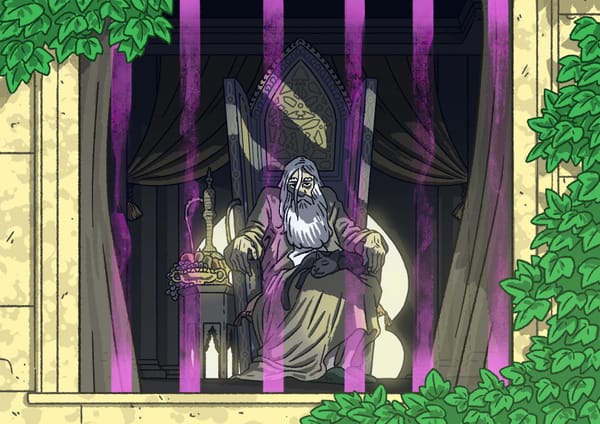A Taxonomy of Magical Taxonomies
How you categorize the magic in your TTRPG setting will have a huge impact on the feel of your game world.
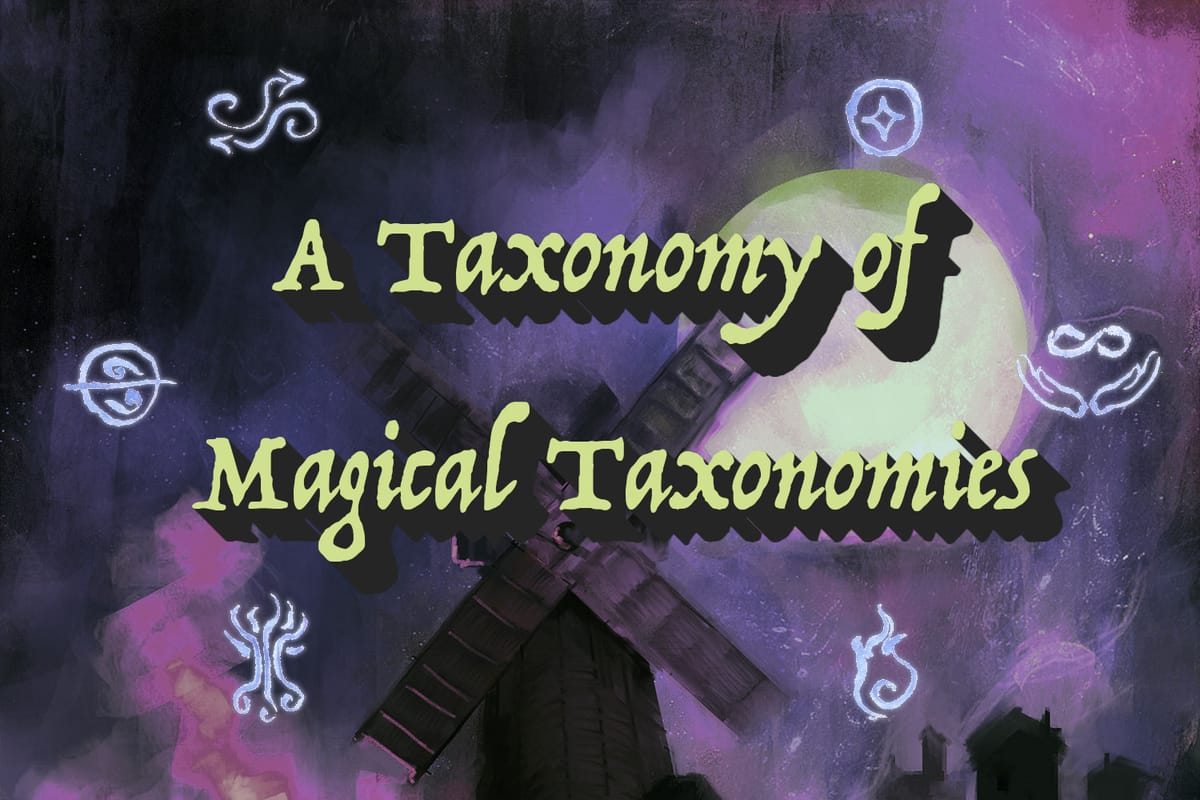
When designing fantasy tabletop systems or campaign settings, it’s often helpful to categorize your different forms of magic. An impossibly huge number of spells, powers, and effects (plus discrete varieties of spellcasters or magical phenomena) is much easier to grasp if everything is lumped into buckets.
Why is this important?
Well, for starters, it helps to show players what they can and cannot do given their chosen character archetype. If you roll a priest character, you should know what sorts of magic counts as “priestly.” Categorization might also allow them to specialize in certain forms of magic, even if they’re capable of wielding other spells (e.g. “I can cast all wizardly spells, but I deal extra damage with fire magic”).
A nuanced magical taxonomy can help add magical richness to your campaign: is there some particular category of magic that only certain villains are casting? Will that knowledge help your forensic investigation of an arcane crime scene? Can your players get ready for a battle by preparing counters for the specific types of magic an enemy might wield? Do they need to beseech some particular sage to break a seemingly unbreakable arcane lock?
All magical categorization systems say something about the world. What kind of story would Avatar: The Last Airbender be were it not for its elemental-themed powers? The force in Star Wars is sometimes totally vague and nebulous, and sometimes perfectly logical and structured, and that tension explains the different vibes of different Star Wars media. Hell, the entire point of most of Brandon Sanderson’s novels is the nuance of how magic works and what is or is not possible for any given person at any given time.
Even though it may seem like a rote exercise, the way in which you categorize your magic can have a profound effect on the mechanics and feel of your tabletop game. Let’s go through the five main ways of categorizing magic and what each sorting scheme offers.
Our DnD Enchanted playlist on Spotify is full of mysterious, magical tunes
Source-Based Magical Taxonomy
Magical abilities are sorted by where the magic comes from or how it is cast. This is probably the most common form of magical categorization. A common trifecta is some version of nature-based magic, divine magic, and scholarly magic. This is one of two(-ish) categorizations that D&D uses. The 2024 ruleset presents 3 spell lists: Arcane, Divine, and Primal. This helps players know exactly what sort of spells they can use based on the choices they make at character creation.
Given that most spellcasters in most magic systems will only have access to a subset of all the magic in a world available to them, divvying the magic up based on where it comes from is extremely convenient. Playing some sort of cleric? Well, then you can cast any magic that comes from your God / the Gods in general. Do you draw your power from some netherworld? Well, then you can only cast spells that come from that netherworld.

Source-based taxonomies are also useful when specific species or creatures have unique forms of magic. Vampiric magic, draconic magic, fae magic, and so forth are all so named because they are tied to particular magical sources. If your player says “how does that vampire do that?” you can just say, “because that vampire has access to dang ol’ vampire magic.”
The tricky bit with this is that the range of sources for magic can quickly get unreasonable if you want to account for all varieties of spells and character archetypes. Even in D&D, the full breadth of magical sources is not totally compatible with the Arcane / Divine / Primal divisions. For example, what is psionic magic? It’s narratively its own thing, but it’s mechanically just a different way to gain access to spells. How about ki-based magic? In a TTRPG that’s as broad and all-encompassing as D&D, a fully comprehensive source-based taxonomy is almost completely non-functional, as there are as many distinct sources as there are distinct spellcasters.
Effect-Based Magical Taxonomy
Magical abilities are sorted by what they are supposed to accomplish. Skyrim is a classic example of this. The six schools of Restoration, Alteration, Illusion, Conjuration, Destruction, and Enchantment fairly neatly map onto the different types of things a spellcaster might want to do. Destruction does damage, Conjuration makes stuff appear, and so on.

D&D also uses an effect-based taxonomy in their spell lists, employing a similar 8 schools: Abjuration, Conjuration, Divination, Enchantment, Evocation, Illusion, Necromancy, and Transmutation. In general, I think this is a more useful distinction than Arcane / Divine / Primal, but the exact rules are sometimes a bit wonky. Why is Teleport a Conjuration spell? Because you’re conjuring yourselves somewhere else? Why is Gust in Transmutation but Gust of Wind in Evocation? Why are some healing spells Evocation and some Abjuration?
The reality is that when you divide magic by intended effect, you often end up with weird edge cases, because most interesting magic can be used for different things. Even Skyrim’s extremely straightforward taxonomy is sometimes misleading. Yes, fire spells can destroy, but they’re also literally used to apply heat for like… 2 different puzzles. That’s got nothing to do with destroying!
Nevertheless, an effect-based taxonomy can be equally helpful for players. When they’ve got a huge spell list, they can sort by effect when they’re looking for the right tool for a job. “Oh, the boss has 5 HP left? What spells do I have that can deal with that? Let me sort by ‘spells that cause creatures to take damage’ or some such.” That’s helpful!
Aspect-Based Magical Taxonomy
Magical abilities are sorted based on some aesthetic or theming. Most commonly, this is elements. Avatar: The Last Airbender has four main types of spellcasting—fire, water, air, and earth—with a handful of subcategories throughout (bloodbending, metalbending, etc.). This works perfectly for the world and leads to basically zero confusion. Everyone other than the avatar gets access to exactly one element, and that element determines what sort of stuff they can do. Neat and clean!
While we’re at it, this is also the method Pokémon uses, and I think Pokémon proves the value of such a taxonomy: codified strengths and weaknesses. The Pokémon "type chart" tells you what powers work best against what creatures. Battles are games of souped-up Rock-Paper-Scissors. This isn’t the right fit for every tabletop game, but an elemental system with mechanicalized strengths and weaknesses can add a lot of satisfying strategy to combat.
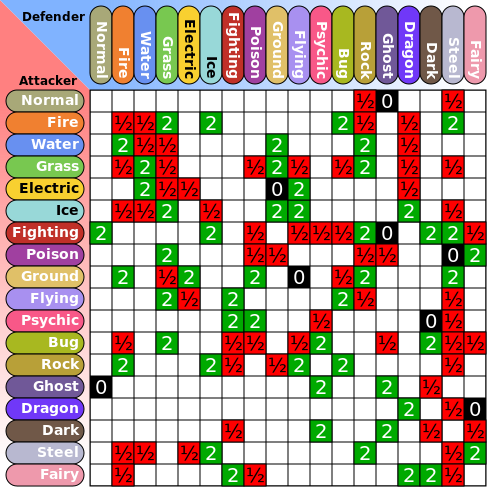
Aspects don’t have to be as straightforward as a typical Pokémon-esque chart. The Malazan books by Steven Erikson use a magic system that’s tied to “warrens,” (basically alternate dimensions each linked to some sort of magical theme). Yes, there are typical warrens aspected to fire and healing and whatnot, but there are also nuanced variants (e.g. darkness vs. shadow), “elder” warrens that most present-day humans can’t access, and quirks based on the state of a warren at any given time. One could argue that this is sort of a “source-based” taxonomy, as each warren is a literal place from which a mage draws power, but it functions more like categorization-by-theme.
I should say that, yes, D&D kind of also has this taxonomy, in that damage-dealing spells all deal acid, bludgeoning, cold, fire, force, lightning, necrotic, piercing, poison, psychic, radiant, slashing, or thunder damage. You could, therefore, categorize a list of spells based on associated elements, but many spells don’t deal damage, and some deal multiple forms. It’s not the neatest way to organize 5e spells, and thus there aren’t too many builds themed around specific damage types.

No Magical Taxonomy
Magic is just magic and remains largely uncategorized. Do you actually need a magical taxonomy? I know my preamble at the top implied you do, but it really depends. If magic is meant to feel truly magical, maybe it should just be an unknowable force in your world.
A setting or TTRPG system with no magical taxonomy (or, instead, a totally invisible taxonomy) usually also has softer worldbuilding. Classic examples here are the films of Studio Ghibli. Whereas most Western fantasy films will go to great lengths to ensure you at least partially understand how magic works (think of Harry Potter, Lord of the Rings, or even Star Wars), magical shit happens all the time in Studio Ghibli movies that never gets properly explained. Why does anything work the way it does in Spirited Away or Princess Mononoke? Who cares! It’s magic! To exhaustively categorize, essentialize, and parameterize the various forms of magic would completely miss the point.
Eschewing or downplaying magical taxonomies is also common in fantasy media where magic is comparatively rare. In A Song of Ice and Fire / Game of Thrones, magic is real, but most people believe it’s gone from the world. There are a few distinct powers certain characters can still access (warging / skinchanging, raising the dead, evoking fire, etc.), but for the most part, magic falls under one big umbrella of “crazy shit that only a handful of people can do.”

Likewise, in Joe Abercrombie’s First Law books, there are basically just two kinds of magic: regular-old wizard magic, and then weirder vampire eater magic. If you check the wiki, you’ll see that a much more rigid classification exists, but in the actual books, the formal distinctions are almost entirely an afterthought. Few of the POV characters can use magic, and those that do barely understand it. Joe Abercrombie simply isn’t interested in doing the whole Brandon Sanderson thing of rigidly codifying every possible magical interaction. That’s not the point of the story.
It sounds like I’m speaking surprisingly highly of the “no taxonomy” system, but it depends on what sort of experience you want for your players. A game like Troika doesn’t organize the spell list at all, because it’s meant to be a pretty zany game where things aren’t so neatly categorized. However, imagine a version of D&D with no schools of magic, no spell lists, and no Divine / Arcane / Primal distinction. Imagine trying to select spells as a first-time player. You would lose your goddamn mind.
Hybrid Taxonomies
Magical abilities are sorted into categories that simultaneously encompass their source, their intended effects, and their aspect. The more you try to explain magic in your world, the more you’re likely to end up in this category. Your categorization system touches on every aspect of how magic works.
Just about every one of Brandon Sanderson’s magical taxonomies fits here. His most complex magical system is probably the Surges from The Stormlight Archive. Each “Order” of magic is tied to a specific “spren” (a metaphysical fairy thing that bestows the power) as a source aspected to a particular “oath” (protection, law, truth, etc), and controls two sets of effects (adhesion, illumination, transformation, etc.). It’s… a lot, but it’s also the crux of the entire planned 10-book story. In fully explaining how every little detail works, Sanderson’s magic systems can’t be summarized by pointing to just one categorization system. Every “form” of magic is distinct in every way.
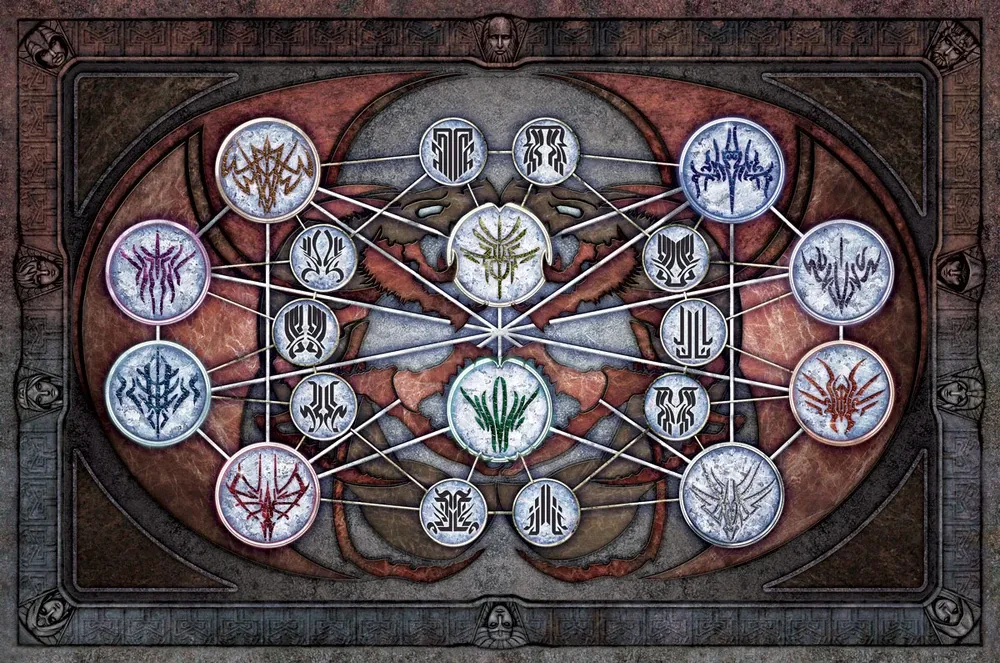
This is sort of what I did when designing the magic schools for Borough Bound’s Elseridge Academy. The 6 schools are The Old Magic, Druidry, Divinity, Cosmology, Alchemy, and Translocation. I wanted these to be system agnostic (i.e. the lore of the Academy will play nice whether you’re playing D&D or Troika or anything else) but also encompass most of the common types of spellcasting archetypes in fantasy TTRPGs.
Each school represents some combination of ideas. For example, Cosmology reflects the magic themed around the stars (its aspect), but it also explicitly allows for a set of defined effects (divination, manipulation of energy, control of light), and a source (knowledge of the cosmos). That may not perfectly map onto the character builds, spell list distinctions, and so forth from your TTRPG of choice, but it should provide enough of a framework so that you can decide whether your Circle of Stars Druid would make more sense in the College of Cosmology or Druidry. These departments are not meant to be completely rigid: someone who wants to learn about enchanting items could do so via the College of Alchemy (enchanting with physical means) or Divinity (enchanting with Godly blessings). It’s complex, but there is also a lot of wiggle room. While magic isn't real, this system is at least more realistic to how academia functions.

A hybrid system is inherently more systematized. You’re explaining more about how any given form of magic works. This might mean you need far more total buckets to describe every possible form of magic. Going back to the Stormlight Archive, my description of the Surges only describes magic for humans in the world. There’s a totally separate collection of systems for the singers, aimians, the shards themselves, plus weirder stuff for dawnshards, old magic, soulcasting… you get my point. A hybrid taxonomy attempts to be exhaustive, and that can be exhausting!
What Taxonomy is Right For You?
I’ve said a whole bunch about magical taxonomies without providing a ton of specific advice. So… what type of taxonomy should you use when breaking down your magic system to your players? I think it depends on what role magic serves in your game.
- Off the top, if you want magic to be truly mysterious and rare, you may not want to systematize it at all. Just let “magic” be a thing that only a select handful of individuals can wield, and maybe even they don’t understand it.
- If you really want to lean into aesthetic theming and/or a rock-paper-scissors strengths / weaknesses system, an aspect-based taxonomy can work perfectly. No need to focus on the metaphysics or go too deep into how and why stuff works. Design a system where some dude can be an ice mage and someone else cast shadow magic. Simple and done!
- The main value of an effect-based taxonomy is straightforwardness for players. If they want to focus on killing things, they spec into the “Killing Things School of Magic.” It’s also a very convenient way to categorize spells such that players always know broadly what a spell does just by reading its name and checking which effect category it’s in.
- Source-based magic is probably the most “lore-rich” system. You might not immediately know much about a spell when you read that it’s tied to “draconic lineage,” but wow, that immediately makes a player ask questions about the world. Like, okay, what sort of wizard cast spells that come from dragons? What does it mean to seek such magic? What happened in history that allowed wizards to harness such energy? The very taxonomy itself invites this narrative rumination.
- A hybrid taxonomy is great if you want to get really crunchy with everything, but the amount of lore you’re tying to each spell might quickly get unruly. The more you explain every little detail about how a spell is linked to some specific spellcasting tradition but can only be cast by certain types of mages and how it works and what element it channels… the less “magical” it will feel. That’s a totally fine fit for worlds where magic is completely documented and understood, but it might be an unnecessary headache for your players.
Figure out what’s important to you about the magic in your world. Is it a mechanical means to an end? A lens through which to understand your worldbuilding? An enigmatic quirk of reality? Focus on function first, and the ideal method of categorization will likely become obvious.

